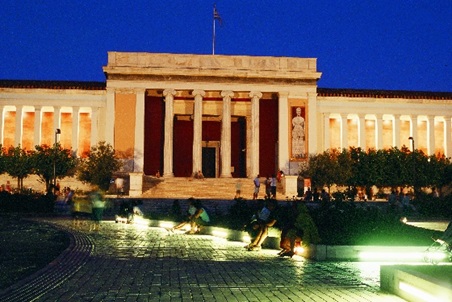National Historic Museum

The National Historic Museum is located in the old Parliament building of Athens since 1960. The museum has assembled various artifacts from the Post-Byzantine years (form 1453) until the Greek –Italian war of the 1940-41.
In this museum one has the unique opportunity to visit the central room of the old Parliament. The seats of the parliament members and the tribune are intact. The room has a unique atmosphere. One can easily imagine that the first steps of the Greek democracy have been taken in this very room. Moreover some of the more important decisions in the Modern Greek history were also made here.
Leaving the Parliament room behind and turning right the visitor will enter the first corridor. Here, one can admire some Post- Byzantine manuscripts. The second room is devoted to the period of the Turkish and Italian occupation of Greece (13th-18th centuries). Weapons and armory can be admired here. In the room number 3 one can witness the first spark of the Greek national conscience. Portraits of famous Fanariotes, the Greek rich and educated class of Istanbul of the 17th and 18th century can be found here. The famous map of Riga is also on display in this room.
The next two rooms present the beginnings of the Greek revolution (1821-1827). There are portraits of known Greek fighters, arms and paintings representing some of the most important battles. In the corridor number 6 the visitor can find the desk and other personal items of the Patriarch of Istanbul Gregory VI. Portraits of members of the Greek intellect can also be found here. Corridor number 7 is devoted to the heroic exodus of Mesologgi and the naval battle of Navarino. Busts of known fighters are on display. There also engravings of the battles. One can also admire the traditional costumes that were worn during this period. Here, there is also the first pressing machine of the Greek National Printing House. In the corridor number 8 artifacts that belong to the philhellenic movement that flourished in Europe in the 19th century are presented. The collection includes embroideries, plates, personal items of the Lord Byron and engravings. In the number 9 room the visitor can see the revolutionary flags of the islands Ydra, Spetses, and Psara, that participated in important naval battles. Memorabilia of the foundation of the New Greek State can be discovered in room 10: the desk and other personal items of Kapodistria, the governor, personal items of Queen Amelia and King Othon.
The room eleven is devoted to the first Greek parliament and the revolution of Crete. Here, King George’s items are presented. Room 12 is on the Balkan war. Flags, arms and items of the battleship Averof are included. On the walls of corridor 13 paintings and posters presenting the events of the Greek-Italian war are displayed. The room 14 contains a reconstruction of the throne room of King George I. A folklore collection containing the traditional women’s and men’s costumes is presented in the rooms 15, 16 and 17. Room 19 presents the official costumes of king Othon’s court.
Address:
13 Stadiou, 10561 Athens
Admission: 3 €
Schedule: 09:00 - 14:00, Closed on Mondays
Contact: Tel.: (+30) 210-3237315
E-mail: info@nhmuseum.gr
Internet Page: http://www.nhmuseum.gr/